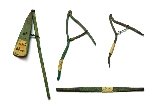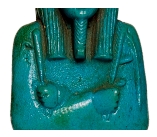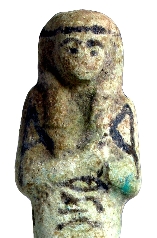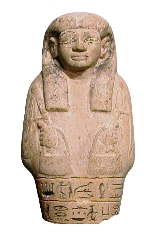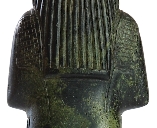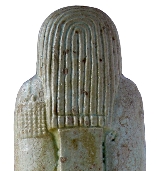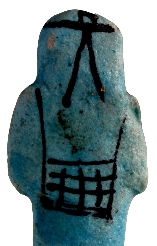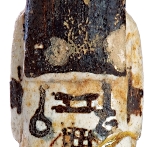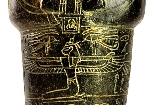

|
|
||||||
|
Accoutrements
During the Middle Kingdom many tombs of the nobility contained model tools
usually made from bronze as part of the funerary equipment
(1). However, in the New Kingdom during the reign of Tuthmosis IV (1419-1386 BC)
they became a feature modelled or painted on
shabtis to enable the figures to carry out the specific tasks specified in the shabti spell.
The most commonly shown agricultural implements on worker shabtis are hoes of which, in everyday life, there were two types, the broad-bladed and
the narrow-bladed hoe. These were made from wood and were in use from the
earliest times in Ancient Egypt. On
shabtis the differences between the two types is often indicated on earlier examples (2) but during the Third Intermediate Period they were very stylised
representations
(3). Pairs of hoes were indicated right through until the Late Period when the
broad-bladed hoe was replaced by a pick
(4). Unlike the wooden hoes, the pick had a metal blade in real life. The basket is
another predominant accoutrement most commonly found on the back of
shabtis. It is generally considered that these were used for carrying grain or seeds.
In everyday life, bags were also used for carrying ears of wheat as the crop
was picked. They were usually made using native plants such as reeds or rushes,
although string was sometimes used. Several tomb scenes show bags of the same
type as those found on
shabtis and being used for such tasks. This is most evident in the ‘Field of Reeds’ scene, also occurring in funerary papyri as well as on tomb decoration. When
sowing or gathering crops the bag would have been held in one hand
(5). Some shabtis, made during the reign of Tuthmosis IV in the early New Kingdom, carry a pair
of bags in front of the body
(6). The baskets are bag-shaped, fairly flat and with a characteristic widening at
the bottom, a form that dates back to the earliest times. This shape of basket
is by far the most common shown on
shabtis. A little later the basket is shown carried behind one shoulder (7) or with two baskets carried behind the back (8).
By the Third Intermediate Period the basket is usually shown in the middle of
the back and worn rather like a modern ruck-sack with carrying straps
(9). By the Late Period the basket appears much smaller in size and slung behind
one shoulder again and usually held by a twisted rope
(10). The positioning of the basket was due to the dorsal pillar becoming an
additional feature in figures of this date.
During the New Kingdom brick moulds were sometimes shown on the back of shabtis (11). Brick manufacture was occasionally stipulated as part of the shabti spell. Water pots carried on a yoke, supported on the shoulders, were also
shown on some New Kingdom shabtis
. The availability of water was obviously a necessity for the making of mud
bricks. The technique for making bricks, either by mixing mud with chopped
straw or sand and animal dung is still employed in Egypt today although this is
a tradition that appears to be dying out in favour of modern building
materials. Brick moulds and water pots are not shown on
shabtis after the New Kingdom.
‘Overseer’ figures from the late New Kingdom until the end of the Third Intermediate
Period carried none of the above mentioned equipment but instead carried a whip
presumably to keep the workers in order
(12).
During the New Kingdom shabtis acquired other attributes, usually hieroglyphs as amulets held in the hands
with specific powers such as the
djed - stability, the ankh - life and the wedjat eye - wholeness (13). Some shabtis have a ba-bird spreading its wings across the chest in a gesture of protection (14).
|
|
|||||
|
|
||||||
|
2. Detail of broad and narrow-bladed hoes on a schist shabti for Pa-hem-neter
New Kingdom, 19th Dynasty
c. 1293-1185 BC
|
|
|||||
|
|
||||||
|
1. Wood and bronze model implements, broad and narrow-bladed hoes and a yoke
From Abydos
Middle Kingdom, 13th-17th Dynasty c. 1782-1570 BC
ex Amelineau collection
|
|
|||||
|
|
||||||
|
|
||||||
|
|
||||||
|
|
||||||
|
|
||||||
|
4. Detail of a pick and hoe on a faience shabti for Psamtek
Late Period, 26th Dynasty
c. 570-526 BC
|
|
|||||
|
|
||||||
|
|
||||||
|
|
||||||
|
3. Simple representation of hoes
Third Intermediate Period, 21st Dynasty c. 1080-945 BC
|
|
|||||
|
|
||||||
|
|
||||||
|
|
||||||
|
5. Fragments from a funerary papyrus
Late Period, 664-332 BC
ex Gloucester Public Library
|
|
|||||
|
|
||||||
|
6. Limestone shabti for Nedjemet showing a pair of seed baskets on the front
New Kingdom, early 18th Dynasty c. 1570-1504 BC
|
|
|||||
|
|
||||||
|
|
||||||
|
|
||||||
|
|
||||||
|
|
||||||
|
8. Detail showing a pair of seed baskets on a serpentine shabti for Huy
New Kingdom, early 19th Dynasty c. 1293-1240 BC
|
|
|||||
|
|
||||||
|
7. Detail of a seed basket carried behind the left shoulder
Third Intermediate Period, 21st Dynasty c. 1080-945 BC
|
|
|||||
|
|
||||||
|
|
||||||
|
|
||||||
|
|
||||||
|
|
||||||
|
10. Detail showing a seed basket positioned to the side of a dorsal pillar
Late Period, 26th Dynasty
c. 664-595 BC
|
|
|||||
|
|
||||||
|
|
||||||
|
|
||||||
|
9. Detail showing a seed basket carried centrally below the wig
Third Intermediate Period,
1080-945 BC
|
|
|||||
|
|
||||||
|
|
||||||
|
|
||||||
|
12. Detail of a whip on an 'overseer' shabti for Djed-Mut-iwef-ankh
Third Intermediate Period, 22nd Dynasty c. 945-715 BC
|
|
|||||
|
|
||||||
|
|
||||||
|
11. Water pots and brick moulds on a shabti for Hor-em-heb
New Kingdom, 20th Dynasty
c. 1185-1070 BC
|
|
|||||
|
|
||||||
|
|
||||||
|
|
||||||
|
|
||||||
|
|
||||||
|
13. Detail of wedjat eyes, winged Isis and scarab pectoral on a schist shabti for Pa-hem-neter
New Kingdom 19th Dynasty c. 1293-1185 BC
|
|
|||||
|
|
||||||
|
14. Detail showing ba-bird on a schist shabti for Huy
New Kingdom, early 19th Dynasty c. 1293-1290 BC
|
|
|||||
|
|
||||||
|
|
|
|
|
|
|
|




























